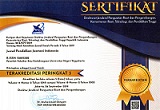PEMETAAN PENELITIAN TEACHING GAMES FOR UNDERSTANDING (TGfU) TAHUN 2000 - 2010
Vol. 9 No. 2 (2013): November
Articles
February 10, 2015
November 1, 2013
Downloads
[1]
Satyaning Rahayu, J. 2013. PEMETAAN PENELITIAN TEACHING GAMES FOR UNDERSTANDING (TGfU) TAHUN 2000 - 2010. Jurnal Pendidikan Jasmani Indonesia. 9, 2 (Nov. 2013). DOI:https://doi.org/10.21831/jpji.v9i2.3015.
Downloads
Download data is not yet available.

Jurnal Pendidikan Jasmani Indonesia is licensed under a Creative Commons Attribution-ShareAlike 4.0 International License.
Based on a work at https://journal.uny.ac.id/index.php/jpji.











